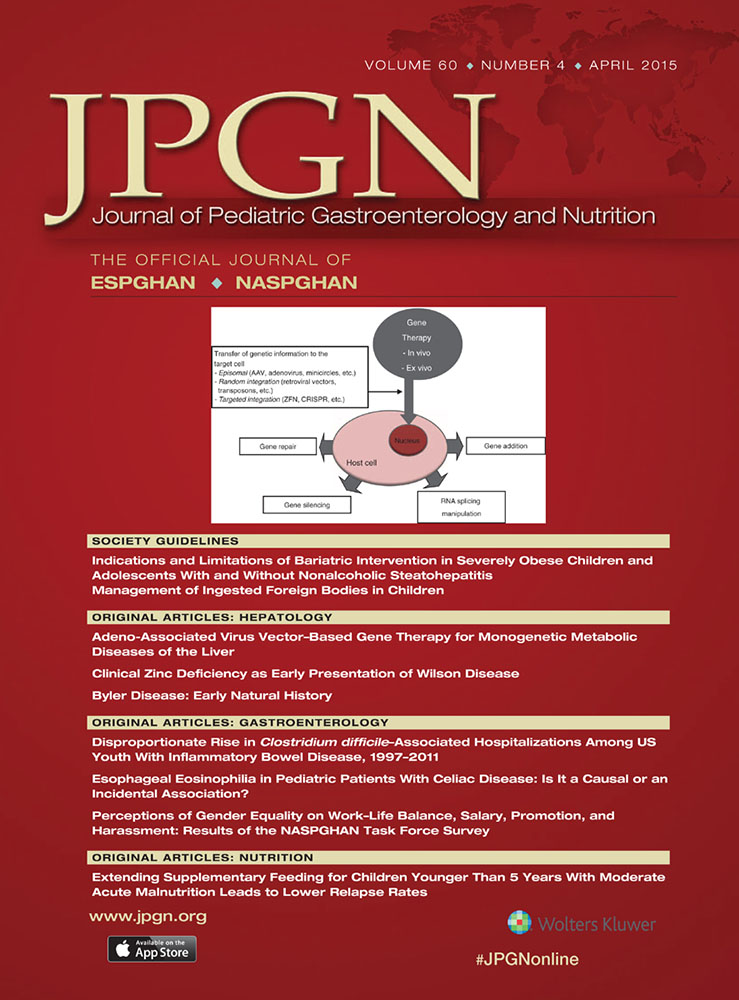Invited Commentaries
Burdening Questions About Clostridium difficile in Pediatric Inflammatory Bowel Diseases
Richard Kellermayer,
Corresponding Author
Richard Kellermayer
Section of Pediatric Gastroenterology, Department of Pediatrics, Baylor College of Medicine, Texas Children's Hospital, USDA/ARS Children's Nutrition Research Center, Houston
Address correspondence and reprint requests to Richard Kellermayer, Section of Pediatric Gastroenterology, Hepatology & Nutrition, Baylor College of Medicine, 6621 Fannin St, CC1010.00, Houston, TX 77030-2399 (e-mail: [email protected]).Search for more papers by this authorRichard Kellermayer,
Corresponding Author
Richard Kellermayer
Section of Pediatric Gastroenterology, Department of Pediatrics, Baylor College of Medicine, Texas Children's Hospital, USDA/ARS Children's Nutrition Research Center, Houston
Address correspondence and reprint requests to Richard Kellermayer, Section of Pediatric Gastroenterology, Hepatology & Nutrition, Baylor College of Medicine, 6621 Fannin St, CC1010.00, Houston, TX 77030-2399 (e-mail: [email protected]).Search for more papers by this authorR.K. was supported by philanthropic funds from the Gutsy Kids Fund, the Karen and Brock Wagner family, and the Houston Men of Distinction.
The author reports no conflicts of interest.

REFERENCES
- 1Sandberg KC, Davis MM, Gebremariam A, Adler J. Disproportionate rise in Clostridium difficile-associated hospitalizations among US youth with inflammatory bowel disease, 1997-2011. J Pediatr Gastroenterol Nutr 2015; 60: 486–492.
- 2Khanna S, Baddour LM, Huskins WC, et al. The epidemiology of Clostridium difficile infection in children: a population-based study. Clin Infect Dis 2013; 56: 1401–1406.
- 3Leibowitz J, Soma VL, Rosen L, et al. Similar proportions of stool specimens from hospitalized children with and without diarrhea test positive for Clostridium difficile. Pediatr Infect Dis J 2014.
- 4Lamouse-Smith ES, Weber S, Rossi RF, et al. Polymerase chain reaction test for Clostridium difficile toxin B gene reveals similar prevalence rates in children with and without inflammatory bowel disease. J Pediatr Gastroenterol Nutr 2013; 57: 293–297.
- 5Mir SA, Kellermayer R. Clostridium difficile infection in newly diagnosed pediatric inflammatory bowel disease in the mid-southern United States. J Pediatr Gastroenterol Nutr 2013; 57: 487–488.
- 6Martinelli M, Strisciuglio C, Veres G, et al. Clostridium difficile and pediatric inflammatory bowel disease: a prospective, comparative, multicenter, ESPGHAN study. Inflamm Bowel Dis 2014; 20: 2219–2225.
- 7Hourigan SK, Chirumamilla SR, Ross T, et al. Clostridium difficile carriage and serum antitoxin responses in children with inflammatory bowel disease. Inflamm Bowel Dis 2013; 19: 2744–2752.
- 8Berry N, Sewell B, Jafri S, et al. Real-time polymerase chain reaction correlates well with clinical diagnosis of Clostridium difficile infection. J Hosp Infect 2014; 87: 109–114.
- 9El Feghaly RE, Stauber JL, Tarr PI, et al. Intestinal inflammatory biomarkers and outcome in pediatric Clostridium difficile infections. J Pediatr 2013; 163: 1697.e2–1704.e2.
- 10Matsuki S, Ozaki E, Shozu M, et al. Colonization by Clostridium difficile of neonates in a hospital, and infants and children in three day-care facilities of Kanazawa, Japan. Int Microbiol 2005; 8: 43–48.
- 11Ozaki E, Kato H, Kita H, et al. Clostridium difficile colonization in healthy adults: transient colonization and correlation with enterococcal colonization. J Med Microbiol 2004; 53: 167–172.
- 12Kato H, Kita H, Karasawa T, et al. Colonisation and transmission of Clostridium difficile in healthy individuals examined by PCR ribotyping and pulsed-field gel electrophoresis. J Med Microbiol 2001; 50: 720–727.
- 13Yatsunenko T, Rey FE, Manary MJ, et al. Human gut microbiome viewed across age and geography. Nature 2012; 486: 222–227.
- 14Faust SN, Wilcox MH, Banaszkiewicz A, et al. Lack of evidence for an unmet need to treat Clostridium difficile infection in infants under 2 years of age: expert recommendations on how to address this issue. Clin Infect Dis 2014.
- 15Clayton EM, Rea MC, Shanahan F, et al. The vexed relationship between Clostridium difficile and inflammatory bowel disease: an assessment of carriage in an outpatient setting among patients in remission. Am J Gastroenterol 2009; 104: 1162–1169.
- 16Horton HA, Dezfoli S, Berel D, et al. Antibiotics for treatment of Clostridium difficile infection in hospitalized patients with inflammatory bowel disease. Antimicrob Agents Chemother 2014; 58: 5054–5059.
- 17Russell GH, Kaplan JL, Youngster I, et al. Fecal transplant for recurrent Clostridium difficile infection in children with and without inflammatory bowel disease. J Pediatr Gastroenterol Nutr 2014; 58: 588–592.
- 18Kellermayer R. Prospects and challenges for intestinal microbiome therapy in pediatric gastrointestinal disorders. World J Gastrointest Pathophysiol 2013; 4: 91–93.
- 19Gevers D, Kugathasan S, Denson LA, et al. The treatment-naive microbiome in new-onset Crohn's disease. Cell Host Microbe 2014; 15: 382–392.
- 20Kelsen JR, Kim J, Latta D, et al. Recurrence rate of Clostridium difficile infection in hospitalized pediatric patients with inflammatory bowel disease. Inflamm Bowel Dis 2011; 17: 50–55.




